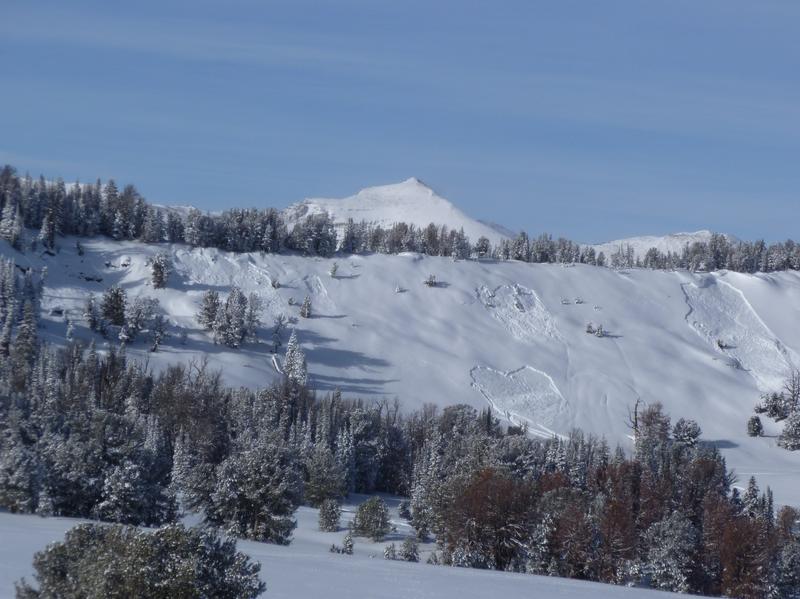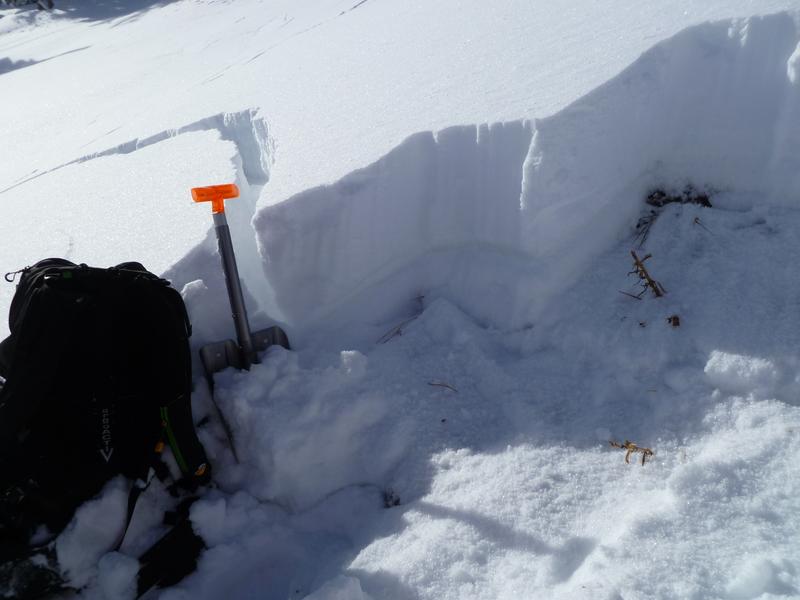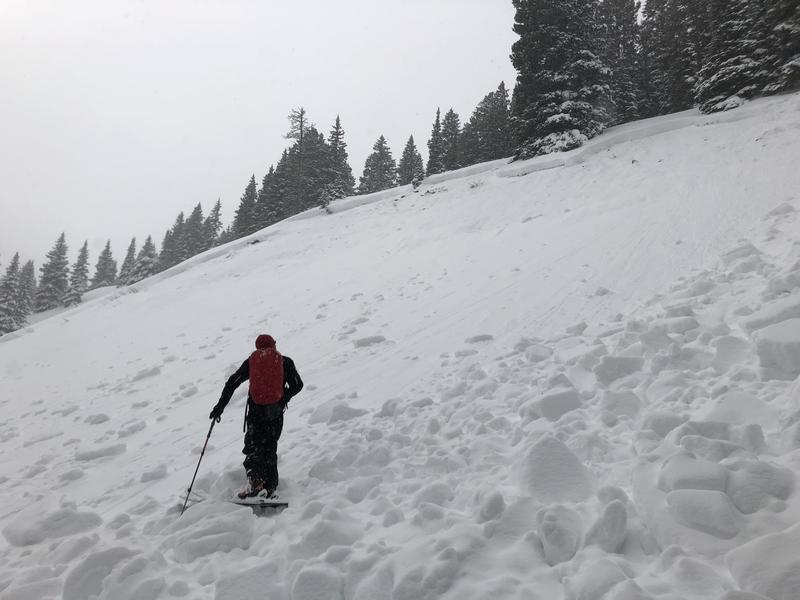
Mark Staples
2015-2024 - Director, Forest Service Utah Avalanche Center
Below is an email thread between UAC staff - storytelling or just lessons they have learned. We are sharing it here for everyone to read.


A good example happened to me a number of years ago. My partner and I had done tons of ECT’s and consistently gotten ECTN (that means no propagation - theoretically a good result). We kept thinking “there just isn’t enough of a slab yet.” But here’s the thing: this type of snowpack will surprise you. It surprised us when we remotely triggered 6 small avalanches at the same time (photo). The slab was only fist hardness (aka very soft), but the weak layer on that slope was incredibly weak. Compared to the weak facets, the slab was relatively cohesive and able to help propagate a fracture through the weak layer for hundreds of feet. That season was a very unstable one and we didn't trust the snowpack for a long time.


I was telling Mark this morning that I was teaching a class in uncompacted terrain at Deer Valley years ago. We had just performed a rutschblock and had gotten an RB6 on depth hoar. As we were putting our skis back on we remoted the adjacent slope to the ground 5' deep 300' wide.
It was my third year patrolling and I was a rookie route leader. I was caught and carried a few hundred feet by a big-man made hard slab while skiing solo on my way to lunch in the fog. The yellow slab of human made snow which easily could have killed me was 2 to 4' deep, 200' wide and failed on a layer of well developed facets near the ground. That avalanche happened in a very similar snow situation as we are in now. A foot or so of sugary facets on the ground. Small storm with only a few inches of new snow and strong winds. Control routes higher on the mountain resulted only in shallow wind slabs. We easily triggered a few soft wind slabs with slope cuts on my route, decided we didn't need shots, and quickly traversed the starting zones on the rest of the route, including the avalanche path the almost killed me. The snowmaking crew had been making snow at the top of the lift. The winds the night before were perfect to transport snow from the guns right into the starting zone of my avalanche path on the lee side of the ridge.
Alone and in the fog (and without the knowledge of anyone on my team) I crossed the closed rope line, descended well into the slide path and stopped, trying to see the line. The avalanche broke about 40' above me, a magic carpet ride into the bushes, and then it rolled over me. Luckily I was standing when the slide stopped. I was buried to my knees and my chest was up against a stout aspen, and both of my skis were broken, I was scraped and bruised and very alone in the fog, and only a few hundred feet below the patrol shack! Back then, our beacons made very quiet, but audible beeping sounds when transmitting. The fog closed out the sounds of the resort, and in the silence after the violence of being crushed by the hard slab, all I remember was hearing the beep, beep, beep, in time with my breaths...
My first season in the La Sals, after a lifetime in the Wasatch, I learned what a continental/faceted snowpack could be like. You could collapse a meadow every day of the week from Dec 1 - March 1. Dangerous avalanche conditions for most of the season. Human triggered avalanches likely on steep, north-facing slopes the whole time.


In 2018/19, the big year, we had a faceted weak layer on a hard crust, about a foot above the ground (just like what we have now) that ultimately resulted in a fatality, numerous natural cycles, and finally a historic event in early March. Every event broke down to that layer. Nevertheless, by early February the pack was showing signs of strengthening, or so it seemed. We weren't seeing any red flags, and ECT's in some areas weren't producing any results at all while in other areas they were much more stubborn than they had been. A week or so later, and another storm or two, some snowmobilers remotely triggered a 200' wide slide from the top of a ridge, right back down to that layer. And it never ceased to be a problem until March when 3" of water in 36 hrs brought it all down.


I've had a few surprises - a layer of SH that surprised us on a BC hut trip after what felt like a week of overall stability. A weak snowpack similar to what we have right now that quickly got a loading event in mid-January: was teaching a Level 1 in Dog Lake Chutes area and had boring pit results. Until we were gathering gear afterward for the skin out and someone hit the sweet spot. (Best Level 1 I ever "taught")
I feel that living in an Intermountain snowpack may be the trickiest. Folks on the coast/BC know when to pay attention to buried SH; those in continental regimes back off with loading. We're in between and generally used to overall stability, but I wonder if it sometimes sets us up for more surprises.
Fortunately and unfortunately, I've never been caught in a slab avalanche. Why I say, fortunately, we all know, many people get lucky and live to tell the tale, as many of you have described in this email string. Why I say, unfortunately, I've not gained the experience and perhaps the humbling nature of being caught in an avalanche and living through it. This doesn't mean I haven't gained the respect of avalanches because I've never been caught. In fact, avalanches to me are both amazing and terrifying at the same time. My biggest fear is drowning at 10,000' cold and in the blackness.
That being said - I think my experience came through my dad when he was caught in 2004 on Kessler Peak. I know what it feels like to lose your loved one to the mountains and the sadness it brings. The avalanche happened around 330pm, and I found out about it at 6 pm with no other information than (three skiers were caught in a large avalanche on Kessler Peak) because of a mix up at the hospital, we were not called or informed that my dad was alive until 10 pm. Longest 4 hours of my life.
I've been surprised by snow many times, and it always resulted because of faceted snow... Brett said to me a long time ago, " NEVER TRUST A FACETED SNOWPACK," and it's stuck with me for a long time. In years that the snowpack has faceted snow, I choose not to play the game with the slope. I will wait until there are no facets. My risk tolerance is basically zero with faceted snow. Once they are gone, I am much more willing to hang it out there with new snow and or wind issues, and that's when I like to get after it.
Hopefully, anyone reading this blog has gleaned a little wisdom that we've learned the hard way. If you ever have any doubt, then there's no doubt. Some seasons are just more stable than others, and we have to wait for them to come. Don’t trust the snowpack for a long time. According to Karl Birkeland from the National Avalanche Center "The line is blurry at best. If you spend much time near the line you’ll end up on the wrong side eventually."
Thanks for your thoughts. Happy new year
Patrick Reddish (not verified)
Thu, 12/31/2020
Thanks for sharing.
Tim (not verified)
Thu, 12/31/2020
This is some priceless stuff. Tone is just right. Great complement to the more formal information, say, in daily observations. Sometimes I get a bit lost in the details. (Still don’t know all the abbreviations in the snow profiles!) These anecdotes provide a wonderful “wisdom profile” on a human/felt level. For me personally, one takeaway is the moral support for patience and waiting. Thank you.
Lisa Sommer (not verified)
Fri, 1/1/2021






